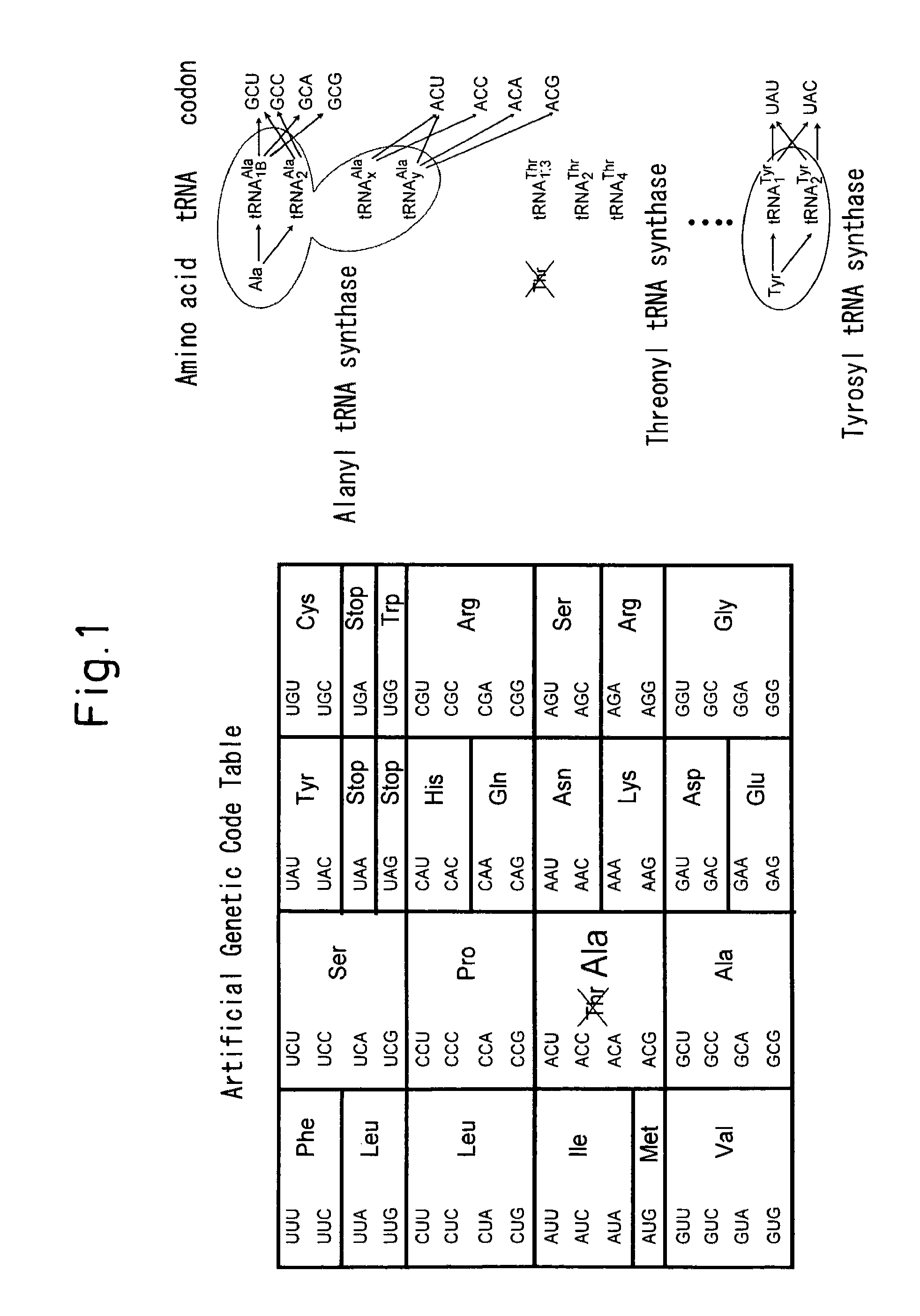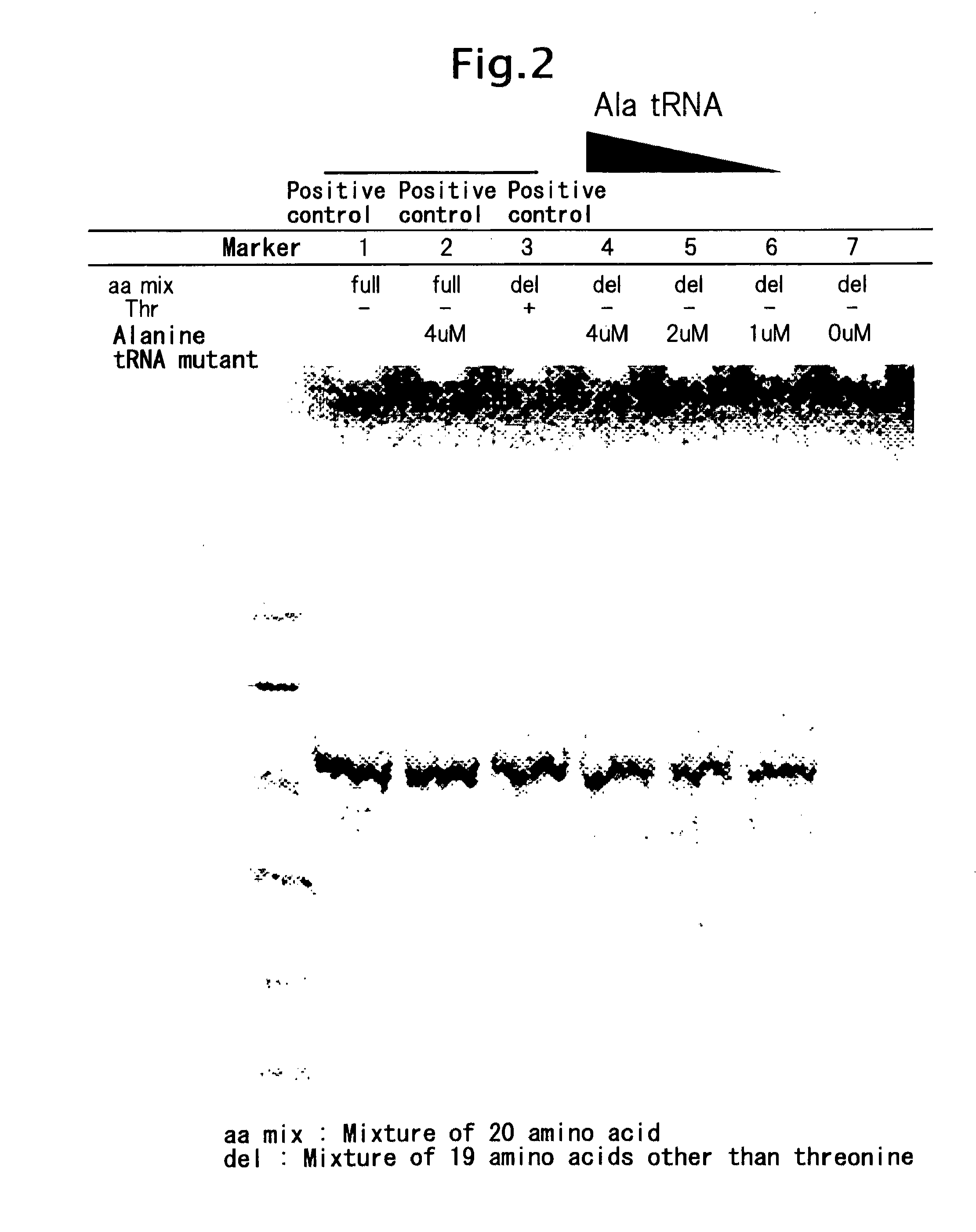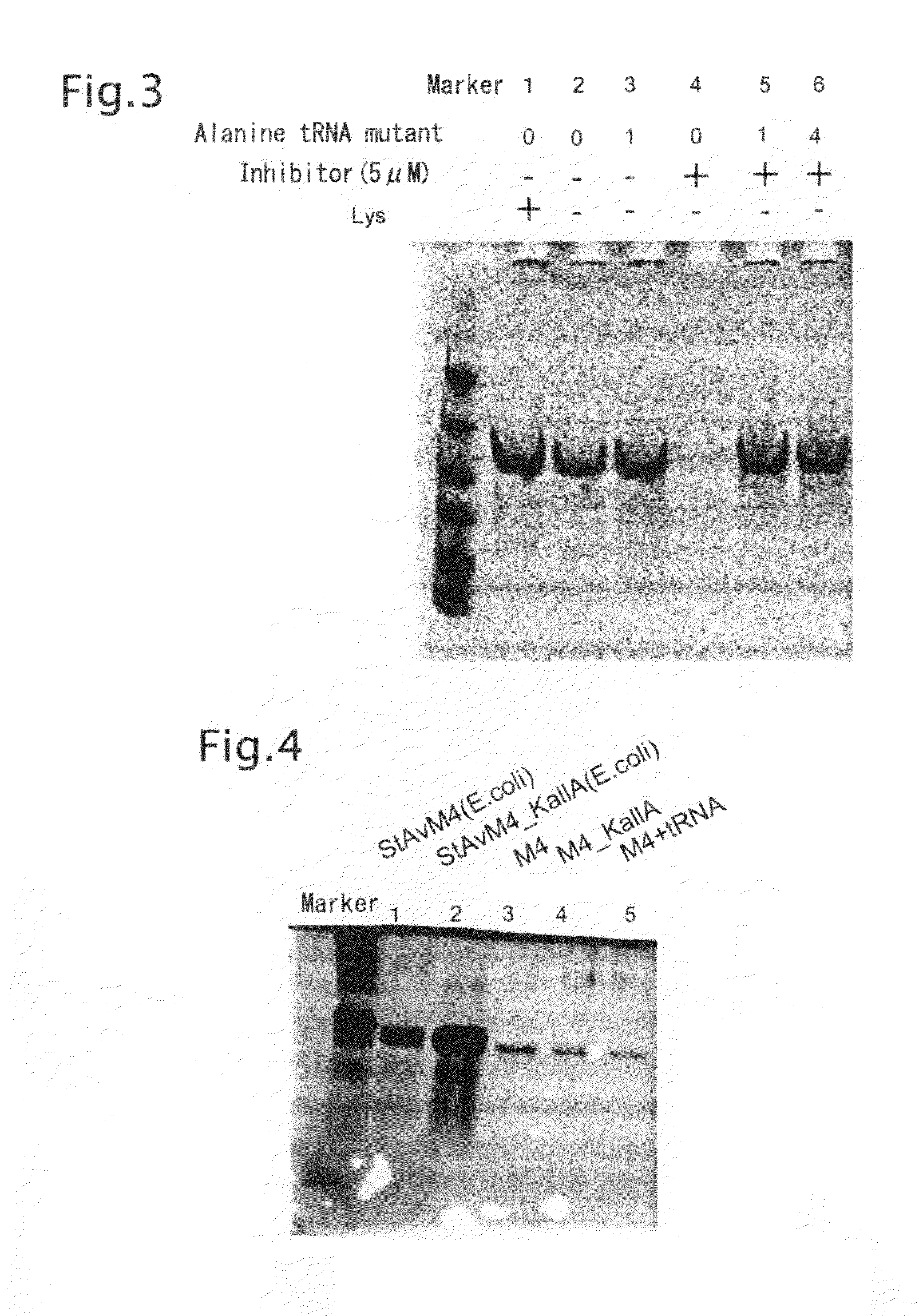Process for producing functional non-naturally occurring proteins, and method for site-specific modification and immobilization of the proteins
a technology of functional non-naturally occurring proteins and process, which is applied in the field of process for producing functional non-naturally occurring proteins and method for site-specific modification and immobilization of proteins, can solve the problems of difficult and inability to apply the technique for the isolation of protein mutants, and achieve the effect of mass production and inexpensiveness
- Summary
- Abstract
- Description
- Claims
- Application Information
AI Technical Summary
Benefits of technology
Problems solved by technology
Method used
Image
Examples
example 1
Preparation of Alanine tRNA Mutant
[0086]
(1) SEQ ID NO: 1: TGTplusGCAGCAAGCTTAATACGACTCACTATAGGGGCTATAGCTCAGCTGGGAGAGCGCCTGCTTTGTACG(2) SEQ ID NO: 2: TGT_minusGTCGGGATCCTGGTGGAGCTATGCGGGATCGAACCGCAGACCTCCTGCGTACAAAGCAGGCGCTCTCCCAGC(3) SEQ ID NO: 3: alaPCRplusGCAGCAAGCTTAATACGACTCAC(4) SEQ ID NO: 4: alaPCRminusGTCGGGATCCTGGTGGAGCTATGCGGG(5) SEQ ID NO: 5: ala_JUSTminusTGGTGGAGCTATGCGGGATCGAACC(6) SEQ ID NO: 6: GGTplusGCAGCAAGCTTAATACGACTCACTATAGGGGCTATAGCTCAGCTGGGAGAGCGCCTGCTTGGTACG(7) SEQ ID NO: 7: GGT_minusGTCGGGATCCTGGTGGAGCTATGCGGGATCGAACCGCAGACCTCCTGCGTACCAAGCAGGCGCTCTCCCAGC
[0087]Template DNA for transcription of an alanine tRNA mutant with the anticodon site replaced by TGT was prepared in the following manner.
[0088]First, 50 μL of PCR reaction mixture containing 5 pmol each of DNA (1) and DNA (2) (the rest of the composition was according to the instruction manual for Takara Pyrobest DNA polymerase) was prepared, and 5 cycles of PCR were performed. Next, 40 pmol each of DNA (3) ...
example 2
Threonine-Excluded Cell-Free Translation Reaction Using Alanine tRNA Mutant
[0093]Cell-free protein synthesis reaction was conducted according to Journal of Structural and Functional Genomics, 2004; 5(1-2):63-8. The composition of the reaction mixture was as follows: 55 mM Hepes-KOH (pH 7.5), 1.7 mM DTT, 1.2 mM ATP (pH 7.0), 0.8 mM each of CTP (pH 7.0), GTP (pH 7.0) and UTP (pH 7.0), 80 mM CP, 250 μg / ml creatine kinase, 4.0% polyethylene glycol 8000, 0.64 mM 3′,5′-cyclic AMP, 68 μM L(−)-5-formyl-5,6,7,8-tetrahydrofolic acid, 175 μg / ml E. coli total tRNA, 210 mM potassium glutamate, 27.5 mM ammonium acetate, 10.7 mM magnesium acetate, 1.0 mM each of amino acids, 14C-leucine, 6.7 μg / ml translation template plasmid, 93 μg / ml T7 RNA polymerase and 30% (w / v) S30 extract. The cell extract S30 used was prepared by purchasing a commercially available kit and dialysing against a buffering solution (10 mM Tris acetate (pH 8.2), 14 mM Mg(OAc)2, 60 mM KOAc, 1 mM DTT). A comparative test was cond...
example 3
Preparation of Alanine tRNA Mutants for Lysine and Cysteine Codons
[0097]Template DNA transcribing an alanine tRNA mutant having the anticodon site replaced by either GCA or TTT was prepared in the following manner.
[0098]The two oligo DNAs GCA_F (SEQ ID NO: 11) and Mut_R (SEQ ID NO: 12) were used against the pALA (TGT) prepared in Example 1 to construct vector pALA (GCA), using a QuikChange Site-Directed Mutagenesis Kit (STRATAGENE). Similarly, TTT_F (SEQ ID NO: 13) and Mut_R were used to construct pALA (TTT).
[0099]
SEQ ID NO: 11: GCA_FTCAGCTGGGAGAGCGCCTGCTTGCAACGCAGGAGGTCTGSEQ ID NO: 12: Mut_RGCAGGCGCTCTCCCAGCTGAGCTATAGCCCCSEQ ID NO: 13: TTT_FTCAGCTGGGAGAGCGCCTGCCTTTTAAGCAGGAGGTCTG
[0100]An alanine tRNA mutant was then prepared in the same manner as Example 1. The sequences were as follows, where the underlines indicate anticodons.
[0101]
SEQ ID NO: 14: tRNA Ala (GCA)GGGGCUAUAGCUCAGCUGGGAGAGCGCCUGCUUGCAACGCAGGAGGUCUGCGGUUCGAUCCCGCAUAGCUCCACCASEQ ID NO: 15: tRNA Ala (UUU)GGGGCUAUAGCUCAGC...
PUM
| Property | Measurement | Unit |
|---|---|---|
| temperature | aaaaa | aaaaa |
| pH | aaaaa | aaaaa |
| pH | aaaaa | aaaaa |
Abstract
Description
Claims
Application Information
 Login to View More
Login to View More - Generate Ideas
- Intellectual Property
- Life Sciences
- Materials
- Tech Scout
- Unparalleled Data Quality
- Higher Quality Content
- 60% Fewer Hallucinations
Browse by: Latest US Patents, China's latest patents, Technical Efficacy Thesaurus, Application Domain, Technology Topic, Popular Technical Reports.
© 2025 PatSnap. All rights reserved.Legal|Privacy policy|Modern Slavery Act Transparency Statement|Sitemap|About US| Contact US: help@patsnap.com



